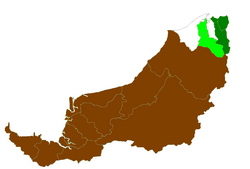Limbang District
| Limbang District | ||
|---|---|---|
|
||
 |
||
| Country | Malaysia | |
| State | Sarawak | |
| District Office location | Limbang | |
| Local area government(s) | Majlis Daerah Limbang | |
| Area | ||
| • Total | 3,976.60 km2 (1,535.37 sq mi) | |
| Population (2000) | ||
| • Total | 40,959 | |
| • Density | 10/km2 (27/sq mi) | |
| District Officer | Anyi Ngau | |
| Ethnicity | Bruneian Malay and Kedayan (30.3%), Iban (24.7%), Chinese (21.3%), Others (23.7%) | |
| Historical claimed by | Brunei | |
The Limbang District is one of the two districts of Limbang Division, Malaysia. It has a total area of 3,976.00 square kilometres. The major town is Limbang. It has one sub-district, which is Nanga Medamit. It borders Brunei Darussalam to the west and east, Lawas District to the southeast and Miri District at the south and southwest. Due to being squeezed in between Brunei Darussalam at its north and coastal areas, Limbang is accessible by road only by going through immigration posts. According to history, this area was annexed by Charles Anthoni Johnson Brooke, the second Rajah of Sarawak in 1890 from Brunei to become the fifth division of Sarawak. The annexation was strongly disputed by Brunei.
The de facto boundary ran along the watershed between the Brunei River and Limbang River basins on the western side of the district, and along the length of the Pandaruan River on the eastern side. Boundary agreements have delineated a stretch of the western border and the Pandaruan River while the other stretches have yet to be delineated.
Limbang area is claimed since 1967 by Brunei as part of its integral territory. The issue was said to have been settled in 2009 as been stated from Bruneian media. However, Bruneian Second Minister of Foreign Affairs and Trade Lim Jock Seng said the issue was never been discussed during the meeting of both countries leaders.
The population of Limbang district (year 2000) was 40,959.
Limbang is traditionally a home to Bruneian Malay, Kedayan, Chinese, Iban and Orang Ulu people.
Limbang is the most culturally diverse and distinct part of Sarawak. It is a melting pot of many cultures, including Malay, Kedayan, Chinese, Iban and various Orang Ulu ethnic groups such as Lun Bawang, Bisaya, Murut, Kelabit and Penan. It has one of the highest concentration of Orang Ulu people in Sarawak.
...
Wikipedia

